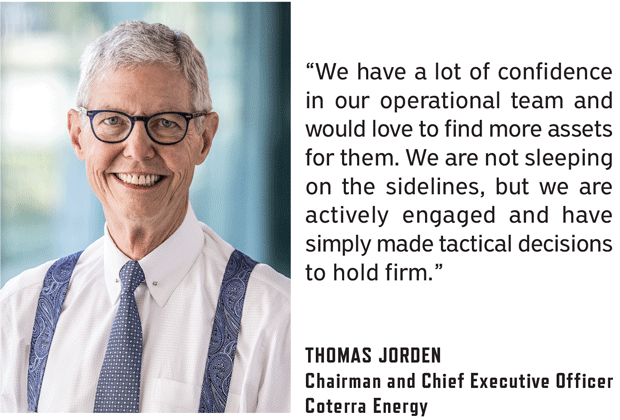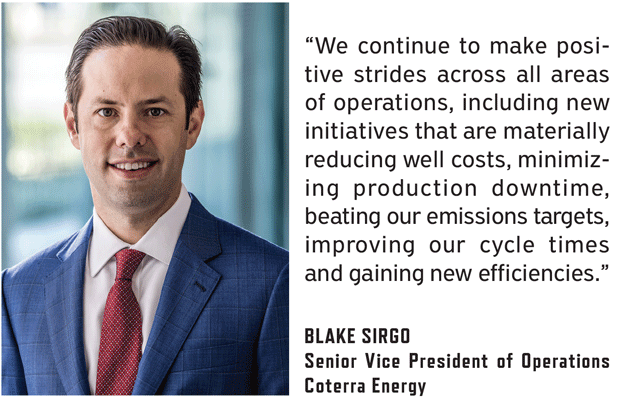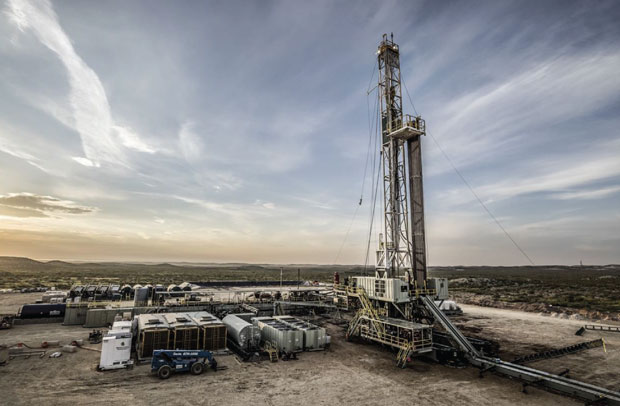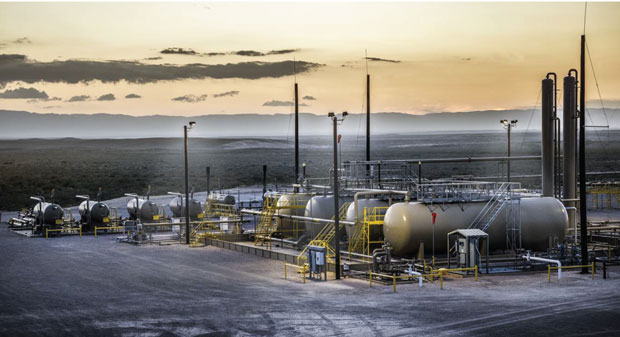
Diversified Portfolio In Top U.S. Resource Plays Gives Coterra Unique Positioning
By Danny Boyd
HOUSTON–The unconventional revolution has swept change into all aspects of the oil and gas industry, from technology to investment strategy. Two of the more obvious recent trends are consolidation and a “pure play” operating paradigm zeroed in on oil or gas targets in particular basins.
Coterra Energy is certainly part of the consolidation trend. The company was formed from the 2021 merger of Cabot Oil & Gas and Cimarex Energy. However, it has taken a different approach than many of its peers by building a portfolio that is almost evenly split between liquids and gas. The company is a key player in both the nation’s largest tight oil basin and its largest shale gas basin, and it complements that one-two punch with a sizeable leasehold in a Mid-Continent basin that produces oil, natural gas and natural gas liquids.
Large and mid-sized operators have swung 180 degrees from the preshale days of favoring a “diversified portfolio” approach with a balance of oil and gas assets across multiple basins. As shale development has matured, the standard strategy increasingly has shifted to a concentrated pure-play operational focus within the relatively confined boundaries of a core operating area.
Coterra is built on a different model at the intersection where a diversified portfolio strategy meets the pure play paradigm. By virtue of its predecessors, Cabot and Cimarex, it effectively has three core areas with the optionality to target oil, gas or NGLs based on market conditions. As the company describes itself on its website: “Coterra is a premier, diversified energy company well positioned to deliver superior and sustainable returns. We are built to weather industry cycles with tremendous flexibility between the best oil assets and the best natural gas assets in the country.”
The Coterra story is compelling for many reasons, and investors are paying attention. According to Chairman and Chief Executive Officer Thomas Jorden, the Houston-based company pays out a significant portion of its free cash flow. In the first quarter alone, the percentage reached 90% through a dividend and a $150 million share repurchase.
Jorden adds that Coterra also continues to make the most of technology and strategic planning to drive efficiency gains across its position. At the same time, the company is keeping an eye on merger and acquisition possibilities, as well as acquisition and divestiture opportunities.
Overall, he says, the distribution of 664,000 net acres is giving Coterra plenty of options to shift capital westward to take advantage of higher liquids prices while continually assessing conditions that will determine when natural gas spending rebounds in the East.
Flexible Approach
With oil prices substantially outperforming gas on a Btu basis over the past several months, Coterra’s 2024 budget is preferentially weighted toward oil projects in the Permian and Anadarko that the company predicts will deliver highly competitive returns on investment. However, the company’s strategy recognizes that conditions change, and sometimes do so quickly and dramatically. Jorden points out that anticipated demand growth from liquified natural gas exports, near-term power needs and surging power requirements at AI-driven data centers may strengthen into more favorable market conditions for natural gas in the months and years ahead.
Many of those data centers will be located along the East Coast, giving Appalachia producers additional local outlets, says Blake Sirgo, Coterra’s senior vice president of operations.
Sirgo reports that Coterra is currently in fact-finding mode, with the company’s executive team holding discussions with various AI-data interests, utilities and other power generators. In Appalachia, the company already benefits from two contracts supplying gas directly to power generators.
“We are ready, willing and able to do more of those types of deals, including for behind-the-meter generation,” Sirgo explains. “We already move gas on just about every pipeline in the Northeast and can easily cut a deal directly with the data centers themselves or power generators.”
Gas production in Texas and Oklahoma similarly can be directed to data centers in the region and to industrial users and LNG export terminals on the Gulf Coast, he says.
Open To Opportunities
In an upstream U.S. market dominated by mega merger and acquisition deals, the absence of any public transactional announcements does not mean that the Coterra is uninterested in building on its portfolio when the opportunity is right, particularly for high-quality bolt-on acreage, Jorden points out.
“We feel good about the decisions we have made, but we have not looked at everything,” he comments. “We have a lot of confidence in our operational team and would love to find more assets for them. We are not sleeping on the sidelines, but we are actively engaged and have simply made tactical decisions to hold firm.”
The company does not have an overarching problem, such an inventory shortage or production holes to fill, that can drive deal decision-making and sometimes motivate buyers to pay more than they really should for available assets, Sirgo adds.
“We love the basins where we operate and we truly get to view all M&A simply through the lens of whether it makes us a better company and whether it creates value for our shareholders and nothing else,” he assesses.
Coterra has no fundamental preference for assets with crude oil, dry gas or NGL reserves, but expanding the oil portfolio will provide additional balance to the revenue mix, Jorden says. Higher oil prices and superior returns have influenced the company to earmark $1 billion this year to the Delaware Basin, where oil production was up 2.5% in the first quarter to 102,500 barrels a day. Across all its assets, the company’s daily production is 686,000 barrels of oil equivalent.
Lining Them Up
In the Delaware Basin, Sirgo reports that Coterra is using a row development strategy that is driving improved operational efficiencies. Tested successfully in 2023, row development includes drilling spacing units (DSUs) with one or two pads on 1,280-acre spacing and wells lined up in a row.
The arrangement allows for drilling, completion, drill-out and turning production on line to occur sequentially and simultaneously across multiple wells.
“We are marching drilling rigs across the rows, and the frac crews come right behind them. We then turn the wells to sales,” Sirgo explains. “This takes all those little efficiencies and adds them up. We are maximizing drilling and frac efficiencies because we have so many wells prepared.”
The configuration reduces mobilization time for rigs and frac crews and maximizes pump hours with faster transition times, he relates. It also minimizes infrastructure needed to connect wells to centralized facilities, including tank batteries, processing equipment and compressors that can be accessed from multiple leases and accommodate future development.
At Windham Row in Culberson County, Tx., which Coterra operates in a 50/50 partnership with Chevron, the Upper Wolfcamp is the primary target for the 54-well project spread across six DSUs. Each of the six sections will include seven to 10 wells in the Upper Wolfcamp, and one western section will include three new Harkey wells and an existing Harkey well.
Ongoing work at Windham is translating into 5%-15% lower costs per foot relative to a well that is not leveraging electric fleets, simulfracs or centralized facilities, Sirgo offers. Overall drilling and completion costs for the 75-90 net Permian Basin wells Coterra anticipates in 2024 are expected to be 10% lower this year than last year. These wells’ lateral lengths will average 9,750 feet.
The company is co-developing three Harkey wells at Windham along with the Upper Wolfcamp wells to better understand bench interactions after a similar co-development to the west proved successful.
Electric simulfracs powered by the company’s own 200 megawatt substation are driving cost savings at Windham compared with traditional, diesel-powered zipper fracs.
“Because of our blocky Culberson position, we are able to leverage our substation, which is connected to ERCOT, across our entire Culberson asset, directly powering our electric frac, midstream electric compression, and existing production/operations there,” Sirgo says. “Think of this frac crew like a surge protector. It just plugs in wherever it goes. We are not towing around or maintaining a bunch of generators that follow the electric fleet.”
To date, Coterra has experienced an increase of 1,000 completed feet per day on simulfracs compared with zipper stimulations, achieving a cost decrease of $25/lateral foot, he divulges.
“When we combine our simulfrac efficiencies with the current cost spread between diesel and grid power, we are realizing a total cost savings of $75/foot compared to our current diesel-powered zipper operation alone,” Sirgo elaborates.
Anadarko And Appalachia
In the Anadarko, Sirgo says Coterra has increased drilling feet by 15% and pumping hours by 10% per day, respectively, running two rigs and a frac crew on the liquids-rich portion of 182,000 net acres in western Oklahoma.
Anadarko production in the first quarter averaged 20,000 boe/d of NGLs and 5,000 bbl/d of oil, making it 49% liquids.
“The Anadarko is a really fun asset because of that commodity mix,” Sirgo says. “It is resilient in the face of different commodity prices. Sometimes gas prices carry the day there, and sometimes oil prices do. It helps us when we are deploying capital to know we have that kind of protection on our investments.”
Spending up to $310 million in the basin this year, Coterra plans 20-25 net wells with average lateral lengths of 9,900 feet drilled and completed at an average cost of $1,300/foot.
Recent projects are outperforming legacy offsets. The estimated 60-month production mix at the 3.9 net-well Gaetz project in the Lonerock area is expected to produce 34% NGLs and 30% oil from the Woodford Shale. Five-year production estimates for the 4.4-net well Marilyn Project in the downdip Woodford to the northwest, which came on in the second quarter, suggest it will produce 36% NGLs and 5% oil. The Maxine project updip in Canadian County, scheduled for sales in the third quarter, is expected to produce 37% NGLs and 18% oil from the Woodford and Meramec.
“A lot of these wells were drilled in 2023, and we like to get big chunks of frac activity where we can keep a crew running continuously,” Sirgo explains. “That is when we get our best cost efficiencies. We expect to be pumping fracs all the way through the summer.”
While diverting capital to liquid-rich assets in the Anadarko and Permian, Coterra has room for flexibility on 186,000 net acres in Appalachia. The company already benefits from long-term supply contracts in the region and a position in Susquehanna County, Pa., that produces pure methane and requires little processing to be pipeline-ready, Sirgo points out.
Coterra added 2,500 acres last year from leasing to allow for extended lateral lengths and continues to target long-lateral development, with Lower Marcellus horizontals averaging 9,500 feet and the Upper Marcellus 11,300 feet, further bolstering efficiencies.
In the Permian Basin, Coterra is using a row development strategy with wells lined up on 1,280-acre drilling spacing units. The arrangement allows for drilling, completion, drill-out and turning to sales to occur sequentially and simultaneously across multiple wells to maximize drilling and completion efficiencies while minimizing production infrastructure needs.
Although the company lowered its Appalachia 2024 capital expenditure budget for drilling and completion by 55% earlier in the year and delayed a portion of a wellhead compression program into 2025, it is running one drilling rig and a frac crew. Sirgo notes that Coterra weighs market conditions monthly to guide decision-making, including determining when to turn 12 delayed wells to sales.
The company does not have a specific price or formula that drives a decision to increase activity, although net backs above $1 are desired, Jorden relates. Despite the caution, the company is upbeat amid forecasted demand growth, Sirgo reiterates.
“We are just watching those structural moves in the gas market, and they will show up in prices in time,” he holds. “We want to make sure the changes are not just a blip on the radar and that we are on our way to a sustained gas price recovery.”
Machine Learning
Across the board, operations continue to be supported by an ongoing machine learning initiative that is helping maximize drilling and completion efficiencies, Sirgo says.
Working with third-party vendors early on, staff learned that external machine learning experts did not “speak oil and gas,” which influenced the company to establish its own machine learning team consisting of both reservoir engineers and data scientists working to enhance well placement and frac design.
Coterra continually reviews prior-year drilling programs to see how decisions affected costs and production and constantly assesses how actual results compare with predicted results.
“Because of machine learning, we have seen a true step change over the past three years in terms of whether we meet expectations,” Sirgo comments. “At this point, machine learning is driving almost all our forecasting. We obviously still have reservoir engineers, and engineers do not have to worry about a machine learning model taking their jobs, but they should be worried about a reservoir engineer who uses a machine learning model. It is a really powerful tool that plays a huge role in us hitting our results every single quarter.”
With three geographically dispersed core areas and the optionality to target crude oil, dry natural gas or natural gas liquids based on market conditions, Coterra is built to weather industry cycles with tremendous flexibility between its large lease positions in the top horizontal resource plays.
The company also continues to invest heavily in data and automation, including in the extended use of supervisory control and data acquisition (SCADA) and related software. A control room in Midland monitors operations in the Permian and Anadarko, and a Pittsburgh control room tracks Appalachia. Each location assesses ongoing operations and alarms. With the location of field technicians available via GPS, the centers can quickly dispatch the nearest employee to assess and remedy an issue.
“Our control room operators mostly come out of the field, and they are some of our best and brightest in terms of field operations,” Sirgo states. “They understand what is going on with problems and can dispatch employees all over the place to solve issues. We leverage that with more and more automation in our facility. Our average run time is fantastic and keeps our operating costs down. We do not have nearly as many surprises as we used to because the automation tells us the second something is wrong.”
Measured Approach
The company will continue to take a measured approach financially and operationally, Jorden assures. He points to the fact that not all zones either up hole or down hole are modeled in the company’s public information because Coterra focuses on delivering what it promises from published inventory and is confident it can extract maximum value from each acre.
“We do not model in future cost reductions or future efficiencies unless we have line of sight to them,” Jorden continues. “I have to kind of apologize for that because we are an innovative organization. We wake up every morning and say we have been highly successful and we are worried sick over it because we never want success to get in the way of our progress.”
In the meantime, the company’s operating team is firing on all cylinders, Sirgo emphasizes.
“We continue to make positive strides across all areas of operations, including new initiatives that are materially reducing well costs, minimizing production downtime, beating our emissions targets, improving our cycle times and gaining new efficiencies,” he says. “Our field operations are the heartbeat of our company, and they continue to fuel our momentum.”
Since the merger, the team has built a framework for making investment decisions and continually assesses potential outcomes for a variety of business conditions, Sirgo adds. “We have a baseline for how we look at all our investment opportunities across the entire portfolio in all the basins, and the way we analyze those decisions and how they all roll up is very consistent,” he states.
Sirgo concludes by referencing a Winston Churchill comment that Jorden likes to paraphrase: Plans are of little importance, but planning is essential.
“We plan all the time, and we have plans for every basin,” he says.
For other great articles about exploration, drilling, completions and production, subscribe to The American Oil & Gas Reporter and bookmark www.aogr.com.



















